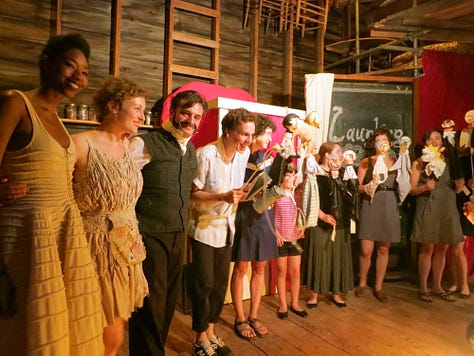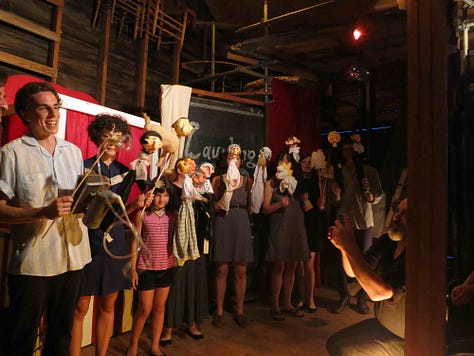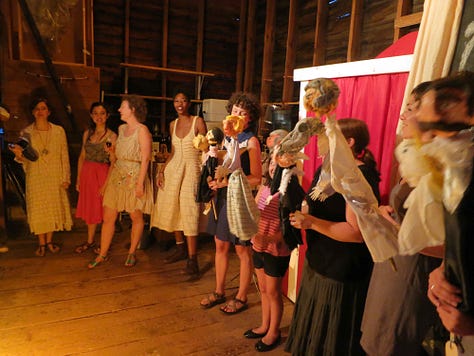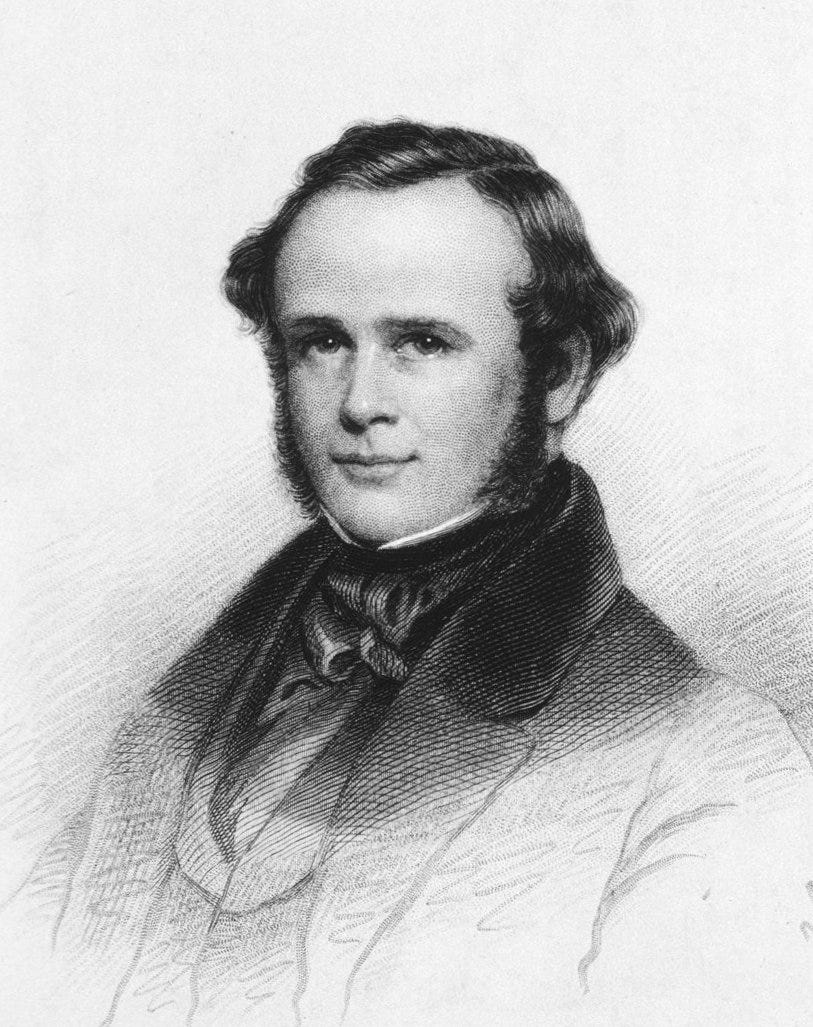[Located deep in the woods of a rural area in northeastern Pennsylvania bordering New York and the upper Delaware River, and created by artists J Morgan Puett and Mark Dion, Mildred’s Lane is an experimental cultural organization and residency program where artists, writers and thinkers collaborate on new forms of critical social engagement. The Lane, as some of us call it, is a very dear place to me: a unique and strong community created in its own terms outside of the models of artists residencies, art schools, studio spaces and learning institutions to be all those things at once. I have been visiting every summer for more than a decade, presenting experimental works reflecting on widely varied issues, from nature to American history. Mildred’s Lane is now embarking in a new chapter, constituting itself as a non-profit organization, building a new future .
This is an abridged version of a puppet opera I presented at Mildred’s Lane in the summer of 2013, to be performed again this Saturday, July 20th, 2024, as part of Mildred’s Lane Corvus Summit.]
[music: Long Long Ago (1833)]
PABLO
This is the painful story of the eradication of pain, and the curse that surrounded all those who attempted it!
We are in the winter of 1844. Medicine, while having made great advances, still confronts one of its greatest hurdles: there is no way to prevent pain during surgery. In hospitals the two most common procedures are removal of tumors and severing of extremities. The screams and pain emerging from the operating rooms from those procedures are intolerable; many young medical students abandon the profession after being part of such operations.
That year, in Hartford, Connecticut, there was an event titled Grand Exhibition of the Effects by Inhaling Nitrous Oxide. During those years, Nitrous Oxide was used at parties merely for entertainment. These demonstrations were usually mayhem; after inhaling, people would roam around the theater laughing, jumping, singing silly songs, tripping all over, thus its name laughing gas.
Amongst the audience was a young dentist named Horace Wells. An ambitious, imaginative, slightly naïve and timid fellow, Wells was captivated by the demonstration. After inhaling, one of Wells’ friends, Sam Cooley, tripped very violently, badly injuring his legs, bleeding badly from the legs; yet he continued laughing; he hadn’t noticed nor was he feeling a thing.
Horace Wells then had an epiphany. If someone inhales this gas and becomes insensitive to a wound, why couldn’t this be used in extracting a tooth without inflicting the usual terrible pain?
The following day he summoned his friends, getting a hold of a bag of nitrous oxide of his own and proposed a tooth extraction of his own after inhaling the gas. He barely felt a thing.
Everyone would later go back and look at that day as the birth of anesthesia.
But if only the world were so easy, if only someone could truly eradicate pain from the world. Pain, in fact, would take revenge on Horace’s effrontery, of his attempt to challenge nature in its own game.
Enter William Thomas Green Morton, another young dentist from Massachusetts. A young man with a dark past as a swindler in California, he was ingenuous however, and had become known for soldering false teeth onto gold plates. He had arrived to Hartford making a small partnership with Wells.
Wells starts applying his new laughing gas system onto his dental patients. Wells is exhilarated by the success of the method. The question becomes: should he patent his discovery?
No, Wells says. The cure for pain should be as free as the natural element that conforms it.
On January 1845 Wells does a demonstration of his system at the Massachusetts General Hospital in Boston. All the doctors, some the best physicians of the time, gather with curiosity to see this discovery. Most are skeptical.
Wells applies the Nitrous Oxide to the patient, and goes on to work extracting the tooth. The tooth comes out, and for a moment it appears that the extraction has been successful. The patient, at that moment, emits an ambiguous grunt. It is unclear what it is. Everyone in the room starts to laugh. “The patient screamed!” they say.” “Humbug!”, “humbug!,” they cry.
Wells is devastated and runs out of the room. The gas has failed, he thinks.
In the middle of the commotion, no one appears to notice the actual patient, who is sitting there saying that she had not felt a thing. But it is too late; the laughter of the room drowns the historical discovery of the laughing gas. Horace Wells has been now labeled a humbug; Wells decides at that moment that he will retire from the practice of medicine forever.
But there was someone else in that room who wasn’t laughing either. William Thomas Green Morton had observed the incident carefully. He knew that Wells was onto something. There was a huge unclaimed discovery for the taking and Morton would take possession of it.
For it, however, and to preserve a sense of distance, he thought about using sulfuric ether, a slightly different substance from laughing gas, as his medium.
Morton convinces the chief physician at Mass General to conduct a public demonstration just as Wells had done, this time with a new substance that would completely eradicate the pain. He takes pains not to reveal the actual substance, even adding oil of orange to conceal the all too familiar smell of ether amongst doctors.
This time the demonstration was successful.
But oh, if only things were so easy, if only a single sniff of a magic substance would allow us to eradicate pain completely. And Pain, we all know, is a vindictive spirit. It doesn’t like it to be ignored, it always strikes back with overwhelming force in the least expected ways.
Morton, will never reveal the true content of the compound that causes insensitivity, to the frustration of the medical community. Instead, he will seek to patent his discovery and make millions of dollars from it. Morton approaches a writer, Oliver Wendell Holmes, to help him find a name for his new invention. Holmes proposes “anesthesia”, from the Greek “unfeeling”.
Except for one small detail: the US patent office won’t accept a patent claim from an unlicensed doctor.
Morton then turns to his former mentor Charles T. Jackson, a renowned scientist who can give full credibility to his patent application. Jackson is also politically connected, as he was the brother-in-law of Ralph Waldo Emerson. Morton offers Jackson to do a joint patent application, and he is delighted when Jackson accepts.
However, Jackson had an agenda of his own. Throughout his life, he would usually claim to have made a discovery in competition with the actual discoverer. He claimed to discover guncotton, the material later used to create photographic film; he contested the invention of the telegraph with Samuel Morse, the discovery of the digestive action of the stomach, and other geological discoveries. Little did Morton know that Jackson would be more than happy to steal Morton’s discovery in the same way that Morton had stolen it from Horace Wells.
Morton manages to get a patent for his invention, amidst the general condemnation of the entire medical community, who accused him of being greedy and inhuman.
Meanwhile, at the Connecticut General Assembly, sensing the injustice made to their native son Horace Wells, and unbeknownst to Wells himself, the lawmakers pass a resolution declaring him the sole discoverer of anesthesia. A war is on: who is the true discoverer of this substance: the man who the medical community laughed at and called a humbug, the greedy scoundrel who first demonstrated the effects of ether but seeks to capitalize from the patent of the discovery, or the elder scientist who claims to have discovered every other discovery of his time? Is it the naïve, is it the evil one, is it the arrogant one?
Speaking of which: where was Horace Wells? Little did he know that now his invention, stolen from his former dentist partner, was making money. Wells had moved to Paris and was trying to make a living as an art dealer, selling reproductions of Michelangelo drawings.
Wells had become errant, aside from selling art also selling canaries and household items. At some point he goes back to New York to experiment, looking for an alternative to ether or laughing gas. He starts researching chloroform, to which he becomes addicted. Wells is to find out by himself, in his search of the eradication of pain, the unerasable pain of the mind.
Reality and fiction are no longer distinguishable, his extremities feel numb, then his vision and hearing begin to fail. In the height of his delusions, he walks out onto the street with a bottle of sulfuric acid that he throws to the clothes of two prostitutes. He is taken to New York’s Tombs prison where he realizes what he has done. He writes a last letter:
“What misery I shall bring to my near relatives, and what still more distresses me is that my name is familiar to the whole scientific world as being connected to an important discovery, and now , while I am scarcely able to hold my pen, I must bid all farewell. May God forgive me…protect my family… I cannot proceed. My hand is too unsteady and my whole frame is convulsed in agony. My brain is on fire.”
Once in his cell, Wells picked a vial of chloroform to inhale one last time, while cutting the arteries of his leg with a razor blade. And in that blissful state, as he bled away, Horace Wells, 33 years old, the discoverer of anesthesia, the man who found insensitivity to the world and was not properly credited in life for his feat, was now gone, thankfully, at least, in a painless death.
[Aria: Una Furtiva Lagrima (Donizzetti, L’Elisir D’Amore, 1831)]
But the evil ghost of Pain had other victims to descend upon: those individuals who had called themselves its master, the self-proclaimed authors of the key to the extinction to pain. No human should ever make that claim; no such audacity should go unpunished.
William Thomas Green Morton would experience his own set of misfortunes. Even though his patent was accepted, it is never implemented. The United States government is the first one to break its own law by the emergency use of anesthesia by medics in the battlefield during the Civil War. Remuneration starts becoming Morton’s obsession and will haunt him for the rest of his life. His patent expires and congress refuses four times to renew it nor to compensate Morton for his discovery.
In June 1868, The Atlantic Monthly, the most respected magazine in the country, published an article about etherization, writing: “the discovery was made by Charles T. Jackson, MD of Boston”… and making only a passing reference to Morton as “a dentist of little medical and almost no scientific knowledge.”
That final judgment must have been the dagger in Morton’s heart, the indescribable pain that no painkiller could have ever erased. He was described as besides himself with anger.
A month after, on the middle of a heat wave in New York City, Morton died of “congestion of the brain”. His death was as messy as his life, a dishonest series of actions that placed him in a dubious place in the history of medicine, putting in question the possible contributions he had made to the discovery of anesthesia.
Surviving Wells and Morton was Charles T. Jackson, now elderly, descending into mental illness. He was placed in an Asylum in Massachusetts, where he spent his last seven years living the end of what a friend called “ a life embittered by a lack of appreciation for his services to humanity and ungrateful indifference to his merits.”
The tragic story of these men brings up a number of questions regarding authorship: does the idea belong to the one who make something first, to the one who announced it first, to the one who attempt it independently first, or to the one who publicized it first?
A few things, however, are true: no one is the exclusive owner of pain or the absence of pain. The human body and the human spirit are not puppets that we can control, that we can dominate and tell them what to feel, when to feel.
And to fight pain, to attempt to dominate it, may only provide a temporary reprieve; suffering and discomfort caused by illness or injury, or even by our own imagination, all that is an inextricable part of being human, of engaging with life, with the great care and trouble of living. To attempt to eradicate our spiritual pain is ultimately to detach from the world, and it is not so different from detaching from life itself.
This is the way it is meant to be, and we might as well embrace this unwelcome guest in the deep river of feeling that is the human spirit.
[Hymn: Come Thou Fount of Every Blessing, (Robert Robinson, 1758)]










Once again you offer a deep and delightful story. Loved it! Reminded me of my grandfather, the recognized inventor of Tampax, who could not market it and sold it for $3,000 to a German woman in the 1930's whose children and grandchildren benefitted from what was a break-through product. My grandmother remembers sewing the cotton together in the early stages. Dr. Earle C. Haas, a general practice doctor, lived to be 96 and died poor.